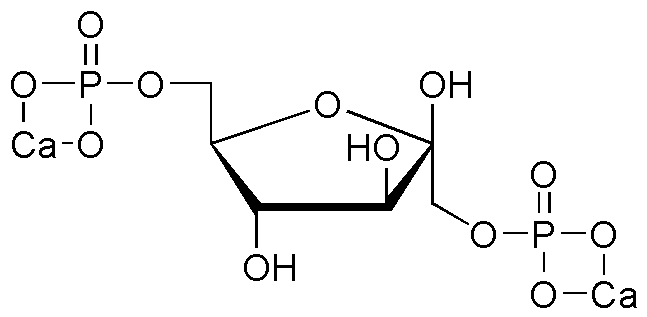D-Fructose 1,6-diphosphate dicalcium salt is widely utilized in research focused on:
- Biochemical Research: This compound plays a crucial role in studying metabolic pathways, particularly in glycolysis and gluconeogenesis, providing insights into energy production in cells.
- Enzyme Activity Studies: It serves as a substrate or activator for various enzymes, helping researchers understand enzyme kinetics and regulation in biochemical reactions.
- Nutrition and Dietary Supplements: The compound is explored for its potential benefits in enhancing athletic performance and recovery, making it relevant in sports nutrition.
- Pharmaceutical Development: It is investigated for its role in drug formulations, particularly in targeting metabolic disorders, offering a pathway for innovative therapeutic solutions.
- Cell Culture Applications: Used in cell culture media to support the growth and maintenance of various cell types, it aids in research and development in biotechnology and pharmaceutical industries.
General Information
Properties
Safety and Regulations
Applications
D-Fructose 1,6-diphosphate dicalcium salt is widely utilized in research focused on:
- Biochemical Research: This compound plays a crucial role in studying metabolic pathways, particularly in glycolysis and gluconeogenesis, providing insights into energy production in cells.
- Enzyme Activity Studies: It serves as a substrate or activator for various enzymes, helping researchers understand enzyme kinetics and regulation in biochemical reactions.
- Nutrition and Dietary Supplements: The compound is explored for its potential benefits in enhancing athletic performance and recovery, making it relevant in sports nutrition.
- Pharmaceutical Development: It is investigated for its role in drug formulations, particularly in targeting metabolic disorders, offering a pathway for innovative therapeutic solutions.
- Cell Culture Applications: Used in cell culture media to support the growth and maintenance of various cell types, it aids in research and development in biotechnology and pharmaceutical industries.
Documents
Safety Data Sheets (SDS)
The SDS provides comprehensive safety information on handling, storage, and disposal of the product.
Product Specification (PS)
The PS provides a comprehensive breakdown of the product’s properties, including chemical composition, physical state, purity, and storage requirements. It also details acceptable quality ranges and the product's intended applications.
Certificates of Analysis (COA)
Search for Certificates of Analysis (COA) by entering the products Lot Number. Lot and Batch Numbers can be found on a product’s label following the words ‘Lot’ or ‘Batch’.
*Catalog Number
*Lot Number
Certificates Of Origin (COO)
This COO confirms the country where the product was manufactured, and also details the materials and components used in it and whether it is derived from natural, synthetic, or other specific sources. This certificate may be required for customs, trade, and regulatory compliance.
*Catalog Number
*Lot Number
Safety Data Sheets (SDS)
The SDS provides comprehensive safety information on handling, storage, and disposal of the product.
DownloadProduct Specification (PS)
The PS provides a comprehensive breakdown of the product’s properties, including chemical composition, physical state, purity, and storage requirements. It also details acceptable quality ranges and the product's intended applications.
DownloadCertificates of Analysis (COA)
Search for Certificates of Analysis (COA) by entering the products Lot Number. Lot and Batch Numbers can be found on a product’s label following the words ‘Lot’ or ‘Batch’.
*Catalog Number
*Lot Number
Certificates Of Origin (COO)
This COO confirms the country where the product was manufactured, and also details the materials and components used in it and whether it is derived from natural, synthetic, or other specific sources. This certificate may be required for customs, trade, and regulatory compliance.


